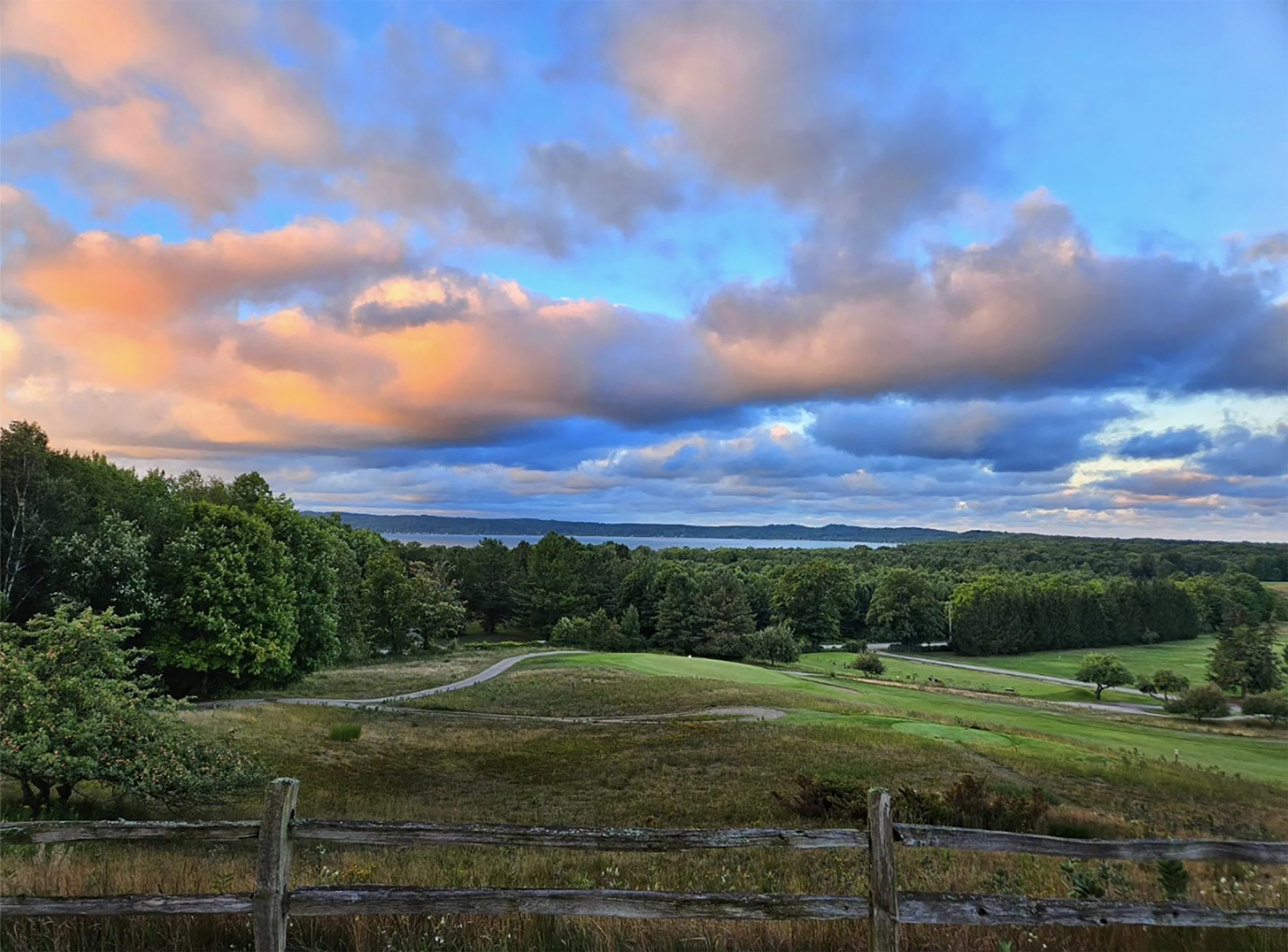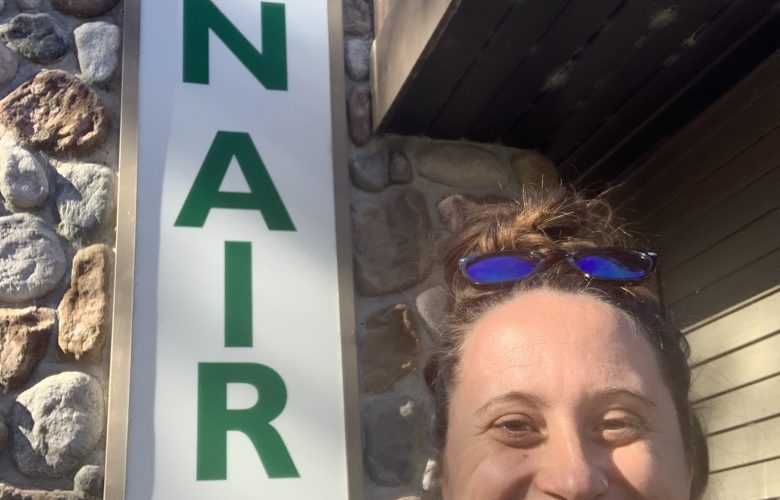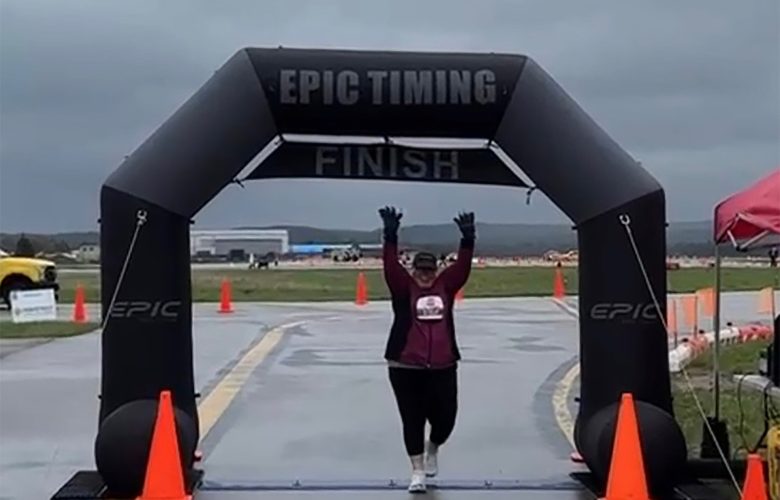History, legacy, and community connections
By Michael Morris
Current Contributor
The adage, “the more things change, the more they stay the same,” applies to many landmarks in Benzie County, where people have been coming to the shores of Lake Michigan and Crystal Lake for well over a century. Even with all of the changes over the years, long-time residents and visitors still find this special corner of the world recognizable through the years—the remarkable places, the spirit of the people, and the passion for this region. (Unfortunately, the same cannot be said for many other developing and fast-growing communities in Northern Michigan.)
Commerce and industry sparked some of the earliest migration to Benzie County, with the recreation and tourism economies closely followed. Businesses in Benzie County fueled the local economy and helped to build the burgeoning cities to our south with lumber from here, transported by rail and by water
Meanwhile, the stately Frontenac Hotel on Lake Michigan in Frankfort, the Congregational Summer Assembly (CSA) on Crystal Lake, and other resort properties became destinations for people from those southern cities who were seeking escape from the summer heat and finding enjoyment in the unparalleled beauty that this community offers.
Among its many wonderful attributes, Benzie County is also home to the work of two “giants” in the world of golf—Dr. Alister MacKenzie and Perry Maxwell. And in many ways, Crystal Downs Country Club and its membership are also representatives of the unbroken link between our area’s past and its present.
Crystal Downs—the world-renowned, classic golf course between the shores of Lake Michigan and Crystal Lake—is still recognizable as captured in the earliest pictures taken on the property, circa the 1920s and 1930s.
A private country club and unincorporated community of homeowners on about one square mile to the north of Frankfort, Crystal Downs has remained relatively the same in terms of the landscape and architecture, as well as community spirit, for nearly a century.
Founding Fathers
The visionary designers of Crystal Downs put their stamp on the landscape in the late 1920s and early 1930s.
According to various histories—and his Wikipedia page—Dr. Alister MacKenzie (1870-1934) was an English golf course architect who designed more than 50 courses on four continents, and his most notable works include Augusta National Golf Club, which Mackenzie created with Bobby Jones and which opened in Georgia in 1932, having hosted the annual Masters Tournament since 1934; the West course of the Royal Melbourne Golf Club in Australia, which was completed in 1931; and Cypress Point Club, which opened in 1929 in California. (All three of these are still named in Golf Digest’s “Top 10” golf courses in the world, even today.) Additionally, MacKenzie is famous for becoming the consulting architect for the Royal and Ancient Golf Club of St. Andrews in Scotland, which has been around since the 18th century.
MacKenzie was originally trained in Cambridge as a surgeon and served during the Second Boer War in South Africa as a civilian physician with the British Army; it was here that he first became interested in the Boers’ effective use of camouflage. Then during World War I, instead of serving as a doctor, MacKenzie worked as a camoufleur, also known as a camouflage specialist—later in life, this would play a big part in MacKenzie’s golf course designs.
MacKenzie designed his first golf course in 1907, between the two wars. Some of his “modern ideas” at that time included rolling greens that were long/narrow and that were angled from the center of the fairway, large/free-form bunker shapes, and significant contouring—these were all hallmarks of MacKenzie’s particular style.
Ultimately, MacKenzie left his career in medicine completely and began working instead as a golf course designer; in the late 1920s, MacKenzie moved to the United States from the United Kingdom.
In Golf Architecture, MacKenzie’s 1920 book, he writes: “the chief object of every golf course architect worth his salt is to imitate the beauties of nature [and presumably also the hazards] so closely as to make his work indistinguishable from nature itself” and that there “are many attributes in common between the successful golf architect and the camoufleur. Both, if not actually artists, must have an artistic temperament, and have an education in science.”
Meanwhile, Perry Maxwell (1879-1952) was an American golf course architect, and he is known as the “father of Oklahoma golf.” Maxwell is best known for his work at Southern Hills Country Club, established in 1936 in Oklahoma; and Prairie Dunes Country Club, established in 1937 in Kansas; but he also made important changes to Augusta National in 1937. (Editor’s Note: All the above-mentioned golf courses, attributed to both MacKenzie and Maxwell, appear on the “Top 100” lists for golf architecture in the world—and our humble little 18-hole club at Crystal Downs in Benzie County is right at the top with them.)
Maxwell studied classical literature in college and held a banking job, eventually becoming vice president of Ardmore National Bank until his mid-30s, according to his Wikipedia page.
Like many golf-course architects of the time, Maxwell was never formally trained, and he built his first nine holes in 1913 on a former dairy farm that he owned; the remaining nine holes were completed in 1923. Around that same time, he visited Scotland to learn as much as possible about how architects there utilized the landscape and other natural features on their courses.
This heavily influenced Maxwell’s style, which used Mother Nature’s design as much as possible, including naturally occurring geological cliffs, undulating greens, and utilizing the existing topography to design challenging holes—for instance, “Maxwell’s Rolls” is the term given to his greens, known for being large with contoured swells, often necessitating the golfer be below the hole to make a putt.
In all, Maxwell is credited with designing around 70 golf courses and remodeling around 50 others.
By 1931, Maxwell had become a big name in the golf industry, and so MacKenzie invited him to become a partner; the pair had reportedly met several years earlier, when Maxwell visited Scotland.
Despite having just a few short years to work together, MacKenzie and Maxwell would become among the favorite golf course design teams in the country, creating Melrose Country Club in Philadelphia, what is now the Oklahoma City Golf & Country Club, and—of course—Crystal Downs Country Club here in Northern Michigan
Creating The Downs
Crystal Downs Country Club is located on the eastern shore of Lake Michigan, about seven miles north of Frankfort and 40 miles west of Traverse City. The golf course and clubhouse are situated on a narrow strip of sandy, rolling land between the big lake and inland Crystal Lake, offering expansive views of both lakes, beautiful sunrises and sunsets, and fairly constant winds.
At the start, there were two farms that were owned by the Nugent/Oliver and Lockhart families (names that are still recognizable in this area for various philanthropic endeavors, such as the local hospital, art center, and athletic fields). In 1926, a total of approximately 240 acres of land were originally incorporated into the Manitou Realty Company—the men who made it happen were Walkley Ewing, Benjamin Merrick, E.A. Wallace, D.B.K. Van Raalte, and A.H. Landwehr.
The initial vision for Crystal Downs, however, can be attributed to Walkley Ewing of Grand Rapids, who was intimately acquainted with Crystal Lake and the Lake Michigan shoreline. On a hiking trip back in 1912, Ewing first began dreaming about the kind of golf course that he thought would work well on such a unique piece of property.
Following rapid construction of a nine-hole course that opened for play in mid-1927, Ewing regretfully recognized that the initial course design did not do justice to the uniqueness of the land that had so inspired his dream from that first glimpse 15 years previously.
According to the Crystal Downs website, that realization prompted Ewing to write a lengthy letter to Robert Hunter, who had just published a book on golf course architecture. Hunter put Ewing in touch with Dr. Alister MacKenzie, who was just finishing work on Cypress Point Club in California and starting his journey home to England.
But first, MacKenzie and his associate, Perry Maxwell, were ushered to Frankfort in 1928 by Ewing.
Through now unquestioned powers of persuasion, Ewing was able to detour MacKenzie and Maxwell on their train trip from the West Coast to the East Coast into the hinterlands of Northern Michigan.
On their way north by automobile from the train station in Grand Rapids, MacKenzie at first exhibited little interest and seemed more annoyed than enthused by the diversion. But Ewing wisely exited the main road straight north and completed the trip to Frankfort along the winding and scenic Lake Michigan coastline. The dunesland along the lake quickly changed MacKenzie’s attitude, and upon arriving at the Crystal Downs site, MacKenzie’s newly found enthusiasm prompted him to delay his sail back to London.
Fredrick Baird’s history, Crystal Downs Country Club, recounts MacKenzie’s and Maxwell’s enthusiasm for the site, writing:
“Crystal Downs created in Dr. MacKenzie an instant impression of near perfection.”
For roughly 10 days, MacKenzie worked feverishly with Maxwell selecting the course routing, painting green complexes, and creating the 18-hole design that remains essentially unchanged today. Maxwell returned in the spring of 1929 to supervise the commencement of the course construction, and subsequently returned each summer, living in a farm house beside what is now the eighth fairway until 1933, when the back nine was finally completed.
The course was designed to use the natural, hilly terrain as the basis for the layout, with no artificial features. The minor earth-moving needed was accomplished by use of a pond sledge and a team of mules, which photographs show Maxwell directing in his characteristic oilskin long coat and wide-brimmed hat.
Notably, the name “Crystal Downs” had actually been bestowed on the course by Benjamin P. Merrick, a Grand Rapids lawyer who first visited the site in 1926, and along with Ewing, likened the view from the hilltop—where the clubhouse now stands—to an English “downs.” (According to Brittanica, the English Downs are rounded, grass-covered chalk hills in southern England that are characterized by their open landscape and lack of trees. The word “downs” comes from the Old English word “dūn,” which means “hill.”
Through a combination of good fortune, occasional lack of funds, and some wisdom, the golf course and clubhouse have remained essentially true to their original designs.
The English cottage-style clubhouse—which officially opened with a party on July 4, 1929—graces one of the highest points of the property, overlooking both Crystal Lake and Lake Michigan. The building was designed by Grand Rapids architect Alexander McColl, who also designed a number of unique homes on the club grounds and in Frankfort. The clubhouse serves dinner only, though occasional special events will include luncheons, weddings, and parties.
Currently, Crystal Downs occupies approximately 425 acres, having added adjacent properties through acquisition and annexation over the years. The majority of this additional property consists of land to the south and east of Sutter Road, once owned by the Crystal Lake Art consortium and by the Borwell/McMillan estate, as well as the critical dune area, to the west of the golf course and adjoining the Point Betsie Lighthouse property. (Editor’s Note: Crystal Downs Country Club also leases land to the Crystal Lake Yacht Club, the history of which was featured earlier this summer in The Betsie Current’s page and can be found in our online archives.)
Of Crystal Downs’ total 425 acres, the golf course makes up 181 acres, privately owned lots and property make up approximately 117 acres, and “common property”—tennis courts, beaches on Lake Michigan and on Crystal Lake, hiking trails, untouched natural areas—total 127 acres.
Eugene Goebel, a park designer and landscape architect from Grand Rapids, worked with Williams and Works, a surveying company, to lay out the lots and the roads within the Crystal Downs complex. There are currently 87 homes on campus, and approximately 20 vacant lots; homes are owned by individuals who are either members or who have applied for membership, with most homeowners being members. (The homeowners have a separate association that works cooperatively with the Club, which is responsible for the roadway construction and maintenance—but not the snow-plowing—as well as the adjacent common property.
From those 87 homes, the U.S. Census Bureau estimated around 47 full-time residents in 2010 and 55 in 2020; 2010 was the first time that the community was defined as a “census-designated place” (CDP).
Meanwhile, the Club has 300 voting members, and there are an additional 150 that fall under “family,” “honorary,” or “senior” member titles, as well.
There is quite a lengthy waitlist to become a member, and qualifications of membership are an internal/private matter, with new members being referred by existing members. (And each individual may only propose a new member once every five years.) Additionally, because of the strong tradition of the Club having “legacy” members—as in, multiple generations of families who have been members—families have weighted priority on the membership waitlist.
From that group of 300, there is a volunteer-run 12-member “board of governors” and various committees that deal with running the nonprofit—committees include Green, Golf, House, Building and Grounds, Legal, and Personnel, just to name a few.
As far as visiting the Club, it is reserved for members only, so any members of the general public would have to visit with a member. From the Crystal Downs website:
“Crystal Downs is a members-only Club. If you plan to visit Crystal Downs with a member of the Club, we want you to have the information you need to enjoy the culture of this special place. Crystal Downs is a private Country Club with a rich tradition. It is essentially an informal place, without undue rules or restrictions, other than those of good common courtesy. In order to maintain this as a special place to share with family and friends, there are expectations for dress and conduct.”
For instance, unlike almost everywhere else, no alcohol is allowed on the actual golf course, though golfers can come up to the clubhouse for a drink before heading back out to play. There is a dress code for dining in the clubhouse and for playing golf on the course, and cell phone calls are strictly prohibited in all areas except for the parking lots, unless in cases of a “true medical emergency,” with additional suggestions for areas where texting/emailing/picture-taking are allowed
Notoriety
Until the mid-1980s, Crystal Downs often was referred to as Michigan’s “hidden gem.” Its somewhat remote location and rather small membership kept the course out of the limelight of some of MacKenzie’s more notable designs at Augusta National, Cypress Point, and Royal Melbourne, for instance.
That lack of notoriety changed in 1986, though, when a young Ben Crenshaw took a day off from the Buick Open to fly on a private jet to Frankfort and experience Crystal Downs with a local acquaintance; Crenshaw went on to win that year’s Buick Open, and he followed his victory with public comments and articles about his great time at Crystal Downs and his admiration for the course design.
The Club’s history since that time has been followed by golf enthusiasts around the globe, and the course has been privileged to be ranked highly in numerous “Top 100” lists of several respected publications.
• Crystal Downs appears in every golf design critic’s listing of top courses in the world. It has been ranked as high as #11 in Golf Digest’s “Top 100 U.S. Courses,” #14 in Golf Magazine’s “Top 100 Courses in the World,” and is 19th on Golf.com currently. The par four fifth hole and the par five eighth hole are frequently cited as two of the greatest golf holes in the world, according to the Crystal Downs website.
• In 1997, Crystal Downs became a founding club member of the Alister MacKenzie Society, an international organization whose purpose is the preservation of MacKenzie’s writings, course designs, and related historical material.
• However, Crystal Downs has only hosted one tournament of note—the 1991 U.S. Senior Amateur—reportedly because Northern Michigan is so far from population centers and there are not ample facilities to accommodate crowds.
Today, two contemporary golf course architects, Tom Doak and Mike DeVries, are members of Crystal Downs Country Club and are known globally for their restoration and design work—both would say their careers have been inspired by MacKenzie and Maxwell’s initial work at Crystal Downs.
The membership at Crystal Downs continues to make the golf course both a gem in our community and a portal to the world; for instance, Crystal Downs regularly hosts “MacKenzie Society” events which bring golfers together from Argentina, Australia, Great Britain, New Zealand, and other locations around the globe
Continued Legacy
The unique, stunning beauty of Benzie County’s lakes, rivers, and landscapes draws people to the area and entices them to stay. Whether it was Walkley Ewing, with his vision for the Club, or Perry Maxwell with his passion and determination to stay in Michigan and build one of the world’s great golf courses—this place we call home attracts and retains people who “get it.”
The family homes around the Downs have deep and historic legacies, dating back to the inception of the Club. And families of employees connected to the construction of the club and its history of operation—greenkeepers, caddies, cooks, and support staff—reside in Benzie County to this day.
What is it that draws and keeps so many families in this area? Perhaps Elizabeth Purves, the daughter of Walkley Ewing, said it best when she recounted to Club historian David Rosenberger:
“Anyone who comes here is changed; they feel better. This land has such a sense of energy.”
Moreover, the Crystal Downs membership has always had deep roots in our community.
Baird’s history cites many local business leaders’ involvement during the Club’s founding: E.R. “Duke” Luedtke of Luedtke Engineering, Leon D. Rose, president of State Savings Bank, and Custer Carland of Corville Lumber were important local stakeholders during the formative years of the Club. Additionally, Dr. Paul Oliver is also mentioned in the Club’s history, and to this day, Club members serve on the boards and foundations that preserve Dr. Oliver’s namesake hospital in Benzie County.
The first greenkeeper of the golf course was a Benzie County resident and chief engineer at the Point Betsie Lighthouse—Roy Oliver, who had grown up on one of the farms that would later become Crystal Downs.
Meanwhile, the Fairchild family owned a gas station and shop near the entrance to Crystal Downs, eventually selling the property to the Club after the building was lost in a fire in the mid-20th century.
Benzie County residents have always been the foundational workforce for the Club.
For instance, Ron and Clive Haswell followed Roy Oliver as greenkeepers. And the writer of this article, who grew up in Elberta, has been the greenkeeper at Crystal Downs since 1987.
The Club currently employs approximately 135 people each season. Of that group, approximately 85 have attended local schools and/or reside full time in the area. And of the group who live or have lived in the area, 24 have full-time employment.
The benefits provided to this workforce go well beyond the proverbial “view of the bay…” For example, the Club offers scholarships for students enrolled in college, and these student scholars have the opportunity for career mentoring programs with some of the most talented and successful individuals in the membership.
The professional staff at Crystal Downs also has local, national, and international reach in its respective areas of influence. The Club’s staff has served on school boards and other school functions, and they have been involved in local professional and social associations. The professional staff are engaged in national associations dedicated to hospitality management and environmental causes, such as Professional Golf Association of America, Club Managers Association of America, Golf Course Superintendents Association of America, Audubon International, and the Michigan Turfgrass Environmental Stewardship Program. In addition, the golf course management team has been a leader in research that has impacted golf green management around the world.
Even with all the crossover between Crystal Downs and the Benzie County residents through the years, some people may think of Crystal Downs as an entity detached from the local community—after all, the Club is a significant piece of property that is privately owned and primarily enjoyed by its members.
But as illustrated by the direct involvement of residents who belong to the Club in various parts of our local community—members include many Benzie County business owners, graduates of local schools, members of local school boards, and active members of local philanthropic organizations—as well as the Club’s commitment to the local workforce, that sort of thinking is anathema to the Club’s vision and reality.
One of the best examples of the Club’s commitment to the community is “Benzie Day.”
Several years ago, the Club’s former golf professional, Fred Muller, proposed opening the course in the fall to any resident of Benzie County to play golf for free or with a good-will offering. The Club board approved this proposal unanimously, and “Benzie Day” continues to be one of the highlights of our local golfing community. (It should be noted that the free-will donations from “Benzie Day” are returned to the community as $1,000 scholarship awards to graduating seniors at Benzie County Central Schools and Frankfort-Elberta Area Schools.)
Our community is fortunate to have so many wonderful landmarks. But whether one is admiring and enjoying a classic golf course, a historic lighthouse, or the newly restored, 100-year-old Garden Theater, it also is important to understand and appreciate the connection that these places have with the people who call this area home—the people who are drawn to its “energy,” to borrow Elizabeth Purves’s term.
Michael Morris has served since 1987 as greenkeeper for Crystal Downs Country Club, located at 249 Crystal Downs Drive, just a few miles outside of Frankfort. To learn more about this year’s “Benzie Day,” which always takes place on the first Tuesday of October, look for call information for tee times, which will be published in the Benzie County Record Patriot in advance.
Featured Photo Caption: The view at Crystal Downs Country Club includes Crystal Lake to one side (seen here) and Lake Michigan to the other (behind the photo-taker). Photo by Anne Girard-Kelly.




